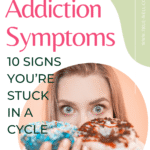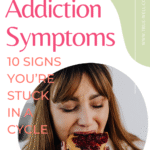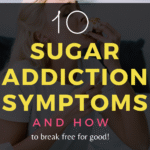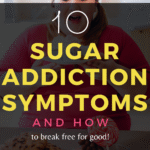If you’ve ever wondered about sugar addiction symptoms, you’re not alone. Anyone who’s tried to lose weight or change to a more whole food or anti-inflammatory diet knows that quitting sugar can be a huge barricade to sticking with it. And it’s no wonder …
Sugar is everywhere.
From salad dressings to spaghetti sauce, it shows up in sneaky ways that most people never even notice. Which helps explain how the average American now consumes around 20 teaspoons of added sugar per day.
And here’s the problem: those extra sugars don’t just affect your waistline.
They affect your energy, mood, cravings, sleep, blood sugar, contribute to chronic diseases (like metabolic disorders, insulin resistance, and heart disease)—and for many women, they drive a deeper cycle of emotional eating that can feel impossible to break.

So how do you know if you’re just enjoying dessert now and then, or if you’re actually dealing with sugar addiction?
Let’s talk through the real symptoms of sugar addiction, how it connects to emotional eating, and what to do if you feel stuck.
👉 First step: Take the free Quiz: What’s Your Best Strategy to Eliminate Emotional Eating to see which level of support your body actually needs.
What is Sugar Addiction?
Let’s start out with what sugar addiction is in the first place. Sugar addiction is more than just liking sweets.
It’s when your body craves sugar so strongly that it starts to override logic and willpower.
You might feel “out of control” around candy, carbs, or baked goods. You might sneak sweets or binge on sugar when no one is watching. And even when you want to stop, you keep reaching for sugar to cope with stress, fatigue, or low moods.
Sound familiar?
I used to think I just had a “bad sweet tooth.”
Until I found myself hiding in the pantry during naptime, shoving cupcakes in my mouth just to get through the day. (I’m now what I call a ‘recovered sugar addict’.)
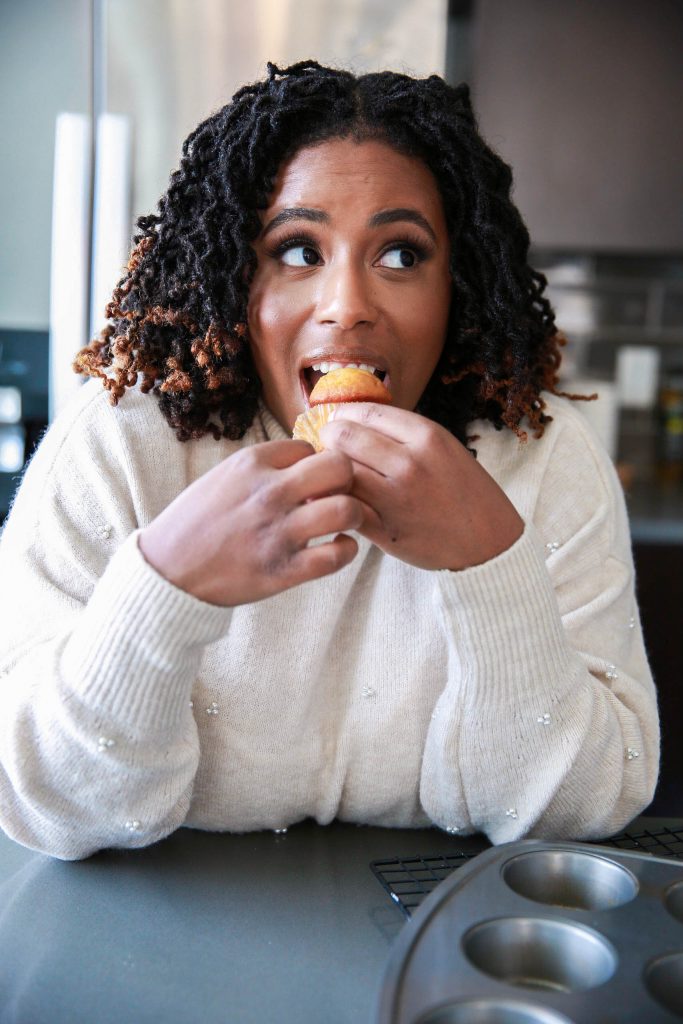
The truth? For many of us, sugar addiction is really a form of emotional eating. It becomes the way we self-soothe, numb out, or try to fix low energy and unstable blood sugar.
Usually these questions don’t arise, and the signs aren’t really noticed, until a doctor’s appointment with a diagnosis of a chronic illness or disease, or the decision for quitting sugar because of the desire (or need) to lose weight.
The Signs of Sugar Addiction
Here are some of the most common sugar addiction symptoms to look for:
1. You crave sugar or refined carbs daily (or constantly).
It could be sweets, chips, bread, or a daily soda habit. You feel a pull toward sugar or quick carbs, even if you’re not physically hungry.
2. You feel out of control around sugary foods.
One bite turns into 10. You feel like you can’t stop, even if you want to.
3. You hide or sneak sugary foods.
You might eat sweets in secret, stash treats, or hide wrappers.
4. You feel shame or guilt after eating sugar.
It feels like you failed again. You promise to “do better tomorrow,” but the cycle repeats.
5. You get withdrawal symptoms when you cut back.
Fatigue, headaches, mood swings, irritability, and strong cravings? Those are classic signs of sugar withdrawal.
Physical Sugar Withdrawal Symptoms
When you stop eating sugar, especially cold turkey, you may experience:
- Extreme fatigue or low energy
- Headaches or muscle aches
- Mood swings, anxiety, or depression
- Insomnia or trouble staying asleep
- Cravings for salty carbs (like chips or crackers)
- Irritability or crying spells
These symptoms are real—and they’re part of why many people go back to sugar quickly.
But here’s the key:
👉 If your sugar cravings come back fast, feel uncontrollable, or bring on shame… you may be dealing with emotional eating, not just sugar addiction.

What’s Your Best Strategy for Eliminating Emotional Eating–for Good?
↓ Take the quiz and find out! ↓
👀 Take the quiz to discover your emotional eating profile and get your personalized strategy—designed to match your current habits, root triggers, and readiness for change.
The Sugar Addiction Cycle
If you’ve ever:
- Quit sugar for a few days
- Felt exhausted or emotional
- Given in to cravings
- Felt ashamed, and started over again…
You’re not alone. That cycle is common. And it doesn’t mean you have no willpower.
For many women, sugar becomes a coping mechanism when other needs (rest, boundaries, stress relief, real food) aren’t being met.
That’s why breaking the cycle starts with awareness—and usually requires more than just a “sugar detox.”

A Smarter Way to Reset
If any of the symptoms above resonate with you, start here:
- Don’t go cold turkey without a plan. Withdrawal is real. Without support, it’s easy to fall back into the cycle.
- Address the emotional triggers. Cravings often show up when we’re stressed, overwhelmed, tired, or lonely. Food becomes the fix.
- Focus on blood sugar balance. Eating more protein, fiber, and healthy fat helps stabilize energy and moods—and reduces cravings.
- Find real support. You don’t have to do this alone. Whether it’s a group, coach, or program, accountability makes a huge difference.
👉 Not sure what kind of support you need? Take the free Quiz: What’s Your Best Strategy to Eliminate Emotional Eating to find your personalized starting point.
The Bottom Line
Sugar addiction is real.
But more often than not, it’s tied to emotional eating patterns and blood sugar imbalances that go way deeper than dessert.
If you feel trapped in the cycle of cravings, guilt, and binging, know this: it’s not your fault. And there is a way to eliminate it for good. (I’m living proof. 😎)
Start by taking the free Quiz: What’s Your Best Strategy to Eliminate Emotional Eating to get a personalized path forward.
And explore the full library of supportive resources in our “Cut the Sugar” Hub to get tools, tips, and support to help you take the next step. 👇
You’re not alone in this.
🤝More Support Inside the Cut the Sugar Hub
Struggling with sugar cravings, emotional eating patterns, or just want to feel more in control around food?
📖The Cut the Sugar Hub is your go-to library of expert-backed articles, practical tools, and science-made-simple guides.
Whether you’re detoxing, breaking the binge cycle, or learning to balance blood sugar the right way—it’s all here.
Know someone who could get help from this post? 📌PIN it or SHARE it!

